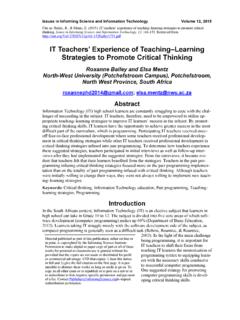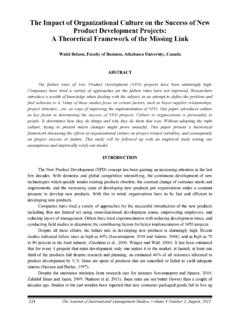Transcription of What makes demand management in the supply …
1 Gest. Prod., S o Carlos : O objetivo deste artigo identificar e analisar os fatores cr ticos de sucesso para a melhoria do desempenho do processo de gest o da demanda na cadeia de suprimentos. A pesquisa foi realizada por meio de m ltiplos casos. Utilizou-se o software NVivo10 como apoio an lise de conte do dos dados. Foram realizadas 40 entrevistas com executivos de 27 empresas distribu das em atacadistas, manufaturas e varejistas do setor de mercearia b sica. A pesquisa possibilitou identificar os seguintes fatores cr ticos: gest o colaborativa (compartilhamento de informa es, planejamento e execu o de a es conjuntas, compartilhamento de recursos e conhecimento, indicadores de desempenho), envolvimento da alta ger ncia, segmenta o de clientes e fornecedores, tecnologia da informa o e n vel de ades o gest o da demanda.
2 Os resultados da pesquisa podem auxiliar no sucesso da implementa o do processo de gest o da demanda na cadeia de suprimentos, pois consolidam uma lista de fatores para que os profissionais possam concentrar seus esfor os e desenvolver estrat gias apropriadas para a melhor gest o da : Gest o da demanda; Gest o da cadeia de suprimentos; Fatores cr ticos de : The objective of this study is to identify and analyze the critical success factors for improvement of demand management performance in the supply chain. This research adopted the multiple-case design, and the NVivo10 software was used to support content analysis. Forty interviews were conducted with senior executives of 27 companies including wholesalers, manufacturers, and retailers within the grocery sector.
3 The following critical factors were identified: collaborative management (information sharing, planning and execution of joint actions, knowledge and resource sharing, and performance indicators), top management involvement, customer and supplier segmentation, information technology, and demand management adherence level. The results obtained can contribute to successful implementation of demand management process in the supply chain by providing a list of consolidated factors that can help professionals develop powerful strategies for effective demand : demand management ; supply chain management ; critical success makes demand management in the supply chain possible? A multiple-case study of critical success factorsO que torna a gest o da demanda na cadeia de suprimentos poss vel?
4 Um estudo multicaso dos fatores cr ticos de sucessoDaniela de Castro Melo1 Rosane L cia Chicarelli Alc ntara21 Departamento de Engenharia de Produ o, Universidade Federal do Tri ngulo Mineiro UFTM, Avenida Doutor Randolfo Borges J nior, 1250, Univerdecidade, CEP 38064-200, Uberaba, MG, Brazil, e-mail: Departamento de Engenharia de Produ o, Universidade Federal de S o Carlos UFSCar, Rodovia Washington Lu s, Km 235, CEP 13560-000, S o Carlos, SP, Brazil, e-mail: Feb. 2, 2015 - Accepted Aug. 15, 2015 Financial support: IntroductionSignificant economic changes such as globalization have fostered market development, and thus companies have been urged to offer greater product variety, customization, and higher service levels. In this new context, demand management is a topic that emerges in the field of supply chain management and marketing seeking to balance and strategically align demand with operating capability across the supply chain through the rapid and successful integration of the market needs in the direction of the suppliers.
5 These changes have posed new challenges for organizations, requiring them to identify customer value perceptions and how they can be transformed into product & Alc ntara (2011) and Santos & D Antone (2014) classify demand management into two approaches: demand management as the integration of marketing and supply management and demand management as a process or component of the supply chain , D. C. et Prod., S o Carlos According to Melo & Alc ntara (2012), demand management , marketing management , supply management , and supply chain management operate together to build customer relationships, develop customer prioritization strategies, provide accurate information to consumers, and establish intra- and inter-firm relationships or joint actions to balance value requirements and operational capabilities.
6 Therefore, in order to maximize shareholder value, integration, coordination, and management of processes and of supply chain and demand activities are necessary (Anning et al., 2013).Through systematic literature review (Anning et al., 2013; Melo & Alc ntara, 2011; Santos & D Antone, 2014), it was found that there is little information to provide guidance on how to implement demand management in supply chains. Most studies available are focused on isolated demand management practices, such as demand forecasting, sales and operations planning (S&OP), collaborative planning, forecasting and replenishment (CPFR), and demand segmentation (Melo & Alc ntara, 2011, 2012).No research that focuses on supply chain agents and addresses the critical success factors to implement demand management across members of the supply chain was identified.
7 Thus, empirical evidence of any positive impact of demand management on supply chain performance is scarce, and most studies available in the literature are theoretical (Bower, 2006; Milliken, 2008).The objective of this study is to identify and analyze the critical success factors for improvement of demand management in the grocery supply chain including manufacturers, wholesalers, and retailers. critical success factors are areas that should receive special attention from organizations to enhance the chances of successful implementation of the demand management process in the supply chain. Therefore, they enable companies to get organized and develop competences to reach demand management maturity to provide customers with better services and, with its proper implementation, improve demand management and its critical success factorsMany authors (Anning et al.)
8 , 2013; Chong & Zhou, 2014; Croxton et al., 2008; Hilletofth & Ericsson, 2007; Hilletofth et al., 2009; Juttner et al., 2007; Mentzer et al., 2007; Mentzer & Moon, 2005; Rainbird, 2004; Vollmann et al., 2004; Walters, 2006; Walters & Rainbird, 2004) assume that demand management involves creating synergies between operations and marketing management to better understand the market and develop actions synchronized with the company strategies, production capacity, and final customer to Esper et al. (2010), the demand and supply integration process begins with the recognition that the organization has a set of strategies and tactics related to the demand and supply management . Having access to this information, managers study the capabilities, constraints, and opportunities of the external environment to generate demand and supply information (Esper et al.
9 , 2010).The next step is the generation and dissemination of knowledge of demand and supply processes through forecasting. Thus, the representatives of these processes and representatives external to the company can share knowledge. The last element of the structure proposed by Esper et al. (2010) is knowledge application, which takes the form of demand plans and operational to Anning et al. (2013), the key elements for the integration between the demand processes and supply processes are good relationships, cooperation, and information sharing between the supply chain et al. (2008) argue that the demand management process requires the integration of strategic sub-processes (provide structure for how the process will be implemented), operational sub-processes (provide the detailed steps for implementation), and the other supply chain management processes (customer relationship management , customer service management , order fulfillment, manufacturing flow management , supplier relationship management , product development and commercialization; returns management ).
10 Hilletofth et al. (2009) believe that there are three important issues that need to be properly addressed to successfully implement demand management : demand generation, demand fulfillment, and coordination of these two processes. Both marketing and supply chain management coordinate these processes according to market demands and require collaboration between the supply chain agents. demand generation involves strategic marketing planning, marketing research, market segmentation, product development, product commercialization, marketing and sales, and product life cycle management . On the other hand, demand satisfaction consists of the strategic supply chain planning, the supply chain design, and the supply chain et al. (2007) proposed three integrative themes for demand management : process, configuration, and social interactions.

















